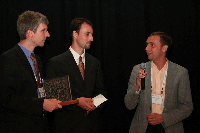Developers of Finite Element Library Receive Wilkinson Prize for Numerical Software
November 19, 2007

Deal developers, from left: Ralf Hartmann (German Aerospace Center, Braunschweig), and Wolfgang Bangerth and Guido Kanschat (both from Texas A&M University).
Writing finite element programs with mesh adaptivity and complex shape functions is a nontrivial task. Handling grids, inputting meshes, and formatting graphical output are among the numerous cumbersome steps required. Using a commercial finite element package can be equally problematic--the routines are sometimes tied to a particular set of equations, limiting the type of application that can be addressed. And the code can be enormous, complex, and difficult to understand.
Three young researchers---Wolfgang Bangerth, Ralf Hartmann, and Guido Kanschat---have developed a finite element software library that overcomes these problems. Their new software, called deal.II, is a large, object-oriented software library that facilitates the implementation of finite element algorithms with mesh adaptivity and complex shape functions. A unified interface provides support for one, two, and three space dimensions. The library is not tied to a particular set of equations and can integrate the work of others. For linear algebra, to give one example, deal.II interfaces to the well-known Argonne PETSc system.
A welcome feature for users is a comprehensive suite of tools designed to free the application programmer from such tasks as mesh refinement and formatting of graphical output.
"The existence of these tools would reduce the model development time for a nonstandard PDE problem (i.e., one beyond the scope of commercial packages) by a large factor," said one external reviewer of deal.II. "The alternative would be to develop a full finite-element solver designed for that problem."
By including extensive documentation, an impressive number of examples, and a Web tutorial, Bangerth, Hartmann, and Kanschat sought to make the data structures and algorithms used in deal.II as transparent as possible.
With an eye to usability, the developers worked to make the code both reliable and portable. Every night, a test suite of several hundred regression tests is run on different machines to guarantee functionality, and the library was built on 30 different combinations of operating systems and compilers to ensure portability.
Efficiency is also a critical concern. According to the library's developers, fast algorithms allow rapid solution of problems with up to several million degrees of freedom. By supporting multithreaded computations, moreover, deal.II accelerates computation on multiprocessor machines.
The open-source package can be downloaded from the Web. With its emphasis on generality and ease of implementation, deal.II has already proved effective in a wide range of applications, including fluid flow, magnetohydrodynamics, biomedical inverse imaging problems, fuel cell modeling, and simulation of crystal growth. To date, more than 60 published papers have included results obtained with deal.II.
For the design and development of deal.II, Bangerth, Hartmann, and Kanschat received the 2007 Wilkinson Prize for Numerical Software in Zurich, at ICIAM '07. Sponsored by Argonne National Laboratory, the National Physical Laboratory, and the Numerical Algorithms Group Ltd., the prize is awarded every four years for the best numerical software developed by young researchers (at most 40 years of age by the year of the award). The prize honors the outstanding contributions of James Hardy Wilkinson to the field of numerical software.

